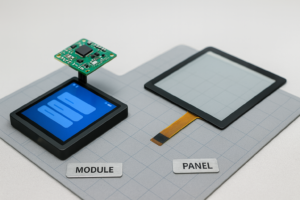In today’s digital world, input devices are essential for how people interact with computers. From traditional tools like keyboards and mice to modern touchscreens, these devices make it possible to send commands and data to machines. Among all input options, touchscreens—particularly capacitive and resistive types—stand out for their wide usage and intuitive design. Understanding the differences between capacitive vs resistive touchscreen technologies can enhance your decision-making when choosing the right device for your needs, especially when considering capacitive vs resistive touchscreen applications.
1. What Are Input Devices?
Input/output (I/O) is a fundamental concept in computing. It refers to how a computer receives data (input) and sends results (output). Common input devices include keyboards, mice, touchscreens, joysticks, and sensors. These tools let users control systems, enter data, and interact with software efficiently.
2. Introduction to Touchscreens
Touchscreens have become a key component of many digital devices, such as smartphones, tablets, point-of-sale (POS) terminals, and industrial machines. They enable direct and natural user interaction with visual content. Capacitive touchscreens are especially popular due to their sensitivity and responsiveness to the human touch, providing a competitive edge in capacitive vs resistive touchscreen markets.
3. Different Types of Touchscreens
There are two primary types of touchscreen technologies:
- Resistive touchscreens: These rely on physical pressure to register touch input.
- Capacitive touchscreens: These detect touch through the electrical signals of the human body.
Each type has unique advantages and is used in different applications depending on requirements like durability, precision, or multi-touch support. Exploring capacitive vs resistive touchscreen advantages can be crucial in specific application needs.
4. Touchscreens vs. Displays: What’s the Difference?
Although they are often combined, a touchscreen and a display are not the same. The touchscreen is the transparent layer that detects user input. The display, typically an LCD, shows images. When placed together, users see and interact with the screen content through the touchscreen.
5. How Do Resistive Touchscreens Work?
A resistive touchscreen consists of two layers—one flexible and one rigid. When a user presses the surface, the layers make contact. This creates a voltage change at the point of contact. An analog-to-digital converter (ADC) reads this voltage to calculate the touch location.
6. Calibrating and Interfacing Resistive Screens
Resistive screens need calibration to align touch points accurately with display locations. These screens connect to systems using either built-in SoC controllers or external chips. Data is typically transmitted using an I2C interface, which converts touch points into digital signals.
7. How Do Capacitive Touchscreens Work?
Capacitive touchscreens detect changes in electrical charge when a finger touches the surface. Your body forms a capacitor with the screen, drawing a small current. This current is detected and analyzed to determine the exact touch location. Unlike resistive touchscreens, capacitive ones can detect multi-touch gestures like pinching or swiping, offering distinct benefits in capacitive vs resistive touchscreen usage.
8. IC Chips and Multi-Touch Functionality
Capacitive touchscreens rely on specialized IC chips to process signals and calculate touch coordinates. These chips handle complex computations and communicate with the host system via digital protocols like I2C. This architecture supports fast response times and multi-touch input.
9. Real-World Applications and Final Thoughts
Touchscreens have revolutionized how we interact with digital systems. From consumer electronics to industrial control panels, they offer simple and efficient interfaces. Knowing how capacitive vs resistive touchscreen technologies work helps designers and users make informed decisions when selecting the right display solutions.
.png)



